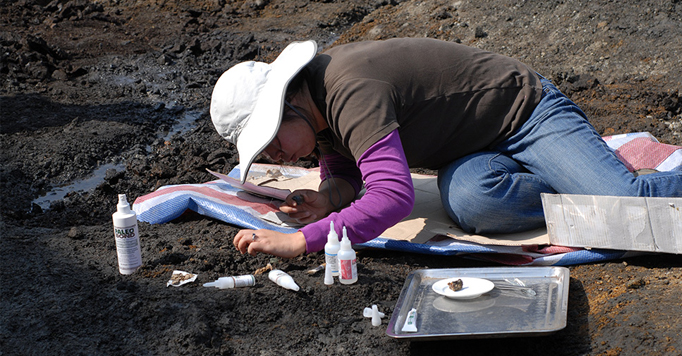
Shuitangba is an open-pit lignite mine located in the Zhaotong Basin of northeastern Yunnan Province of China. While the coal mines of this area have long been known to hold an abundance of fossils, the first systematic survey of the Shuitangba site wasn’t launched until 2007.
That survey, conducted by
Denise Su, Nina Jablonski and Ji Xueping explored the fossiliferous sediments of Zhaotong Basin. Its success led to formation of the
Zhaotong Paleontological Research Project, lead by Jablonski, Su, Ji, Jay Kelley and Lawrence Flynn.
Shuitangba is dated to the end of the Miocene, about 6.1 million years ago, and has thus far yielded hundreds of specimens of animals and plants, including a relatively complete cranium of a juvenile ape that belongs to the species
Lufengpithecus lufengensis.
Preservation of the fossil plants and animals at Shuitangba is excellent. The diversity and abundance of specimens means that it has potential to provide more understanding about the environment during the latest part of the Miocene in southern China, and the evolution of the plants and animals found there.

Shuitangba is in a heavily populated area and the site is surrounded by rice paddies.

Rice harvesting...the traditional way.

In the field
Unlike at Laetoli or Woranso-Mille, all specimens are found in situ and need to be excavated rather than collected from the surface.

In the field
The specimens uncovered are extremely fragile and most require consolidation before removal from the ground.

In the field
One of our excavators carefully uncovering part of an elephant skeleton.

Fossils in the field
The uncovered elephant skeleton. A complete cranium is in the wood box ready for transport to the lab.

Fossils in the field
The juvenile ape cranium in situ.

Fossils in the field

Fossils in the field

In the field
A geochronologist taking samples for paleomagnetic analysis.

In the lab
Many of the specimens need to be plaster-jacketed due to their fragile nature. They are then cleaned and prepared in the field lab before being taken to the Yunnan Cultural Relics and Archaeological Institute to be stored and curated.

In the lab
Specimens are identified in the lab.
-
-
Relevant publications
Ji, X., Jablonski, N
., Su, D. F., Flynn, L., Deng, C., You, Y., and Kelley, J. 2013.
A new juvenile hominoid cranium from the terminal Miocene of Yunnan, China. Chinese Science Bulletin 58: 3771-3779.